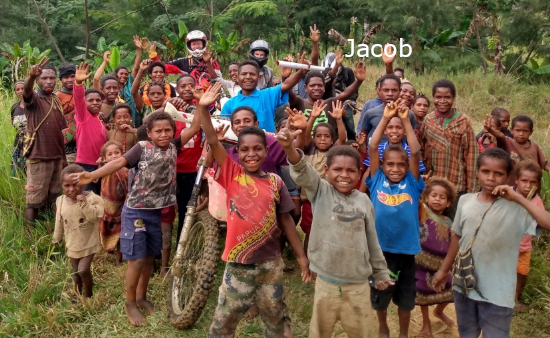In prior newsletters I have mentioned the fact that Enga uses suffixes to indicate the source of information for a statement. For example, if I were to say, “It is raining,” I would use one suffix if I saw that it was raining, but I would use another suffix if I only heard the rain hitting the roof (but didn’t actually see it). These suffixes are called evidentials, and they are also used to classify realizations that people make or conclusions that people draw. For example, just this week I told the Enga translation team that there are not many notes for them to check in the book of Revelation. I also told them that the chapters in Revelation were short, and so they should be able to finish checking the book of Revelation quickly. They responded by saying, “Dopa-tamo doko, yapa pyoo etalamane-lumu,” which means, “If that is the case, we will seemingly finish quickly. The word seemingly is about the closest I can come to translating the suffix -lumu. By using the suffix -lumu, the team was indicating that their conclusion was based on the information that they heard from me. A similar suffix is -lamo, which indicates a conclusion drawn from visual evidence. For example, if the team had glanced through Revelation and seen that there are not many notes and that the chapters are short, they could have reached the same conclusion based on visual evidence.
Until recently, we were using the suffixes -lumu and -lamo with some statements in the New Testament made by God and Jesus. The more we thought about it, however, the more we realized that neither God nor Jesus would use such evidentials. Because God is omniscient (all-knowing), it is not generally proper to portray God as making a realization or coming to a conclusion at a particular point in time. Doing so would seem to suggest that God did not know that particular fact before that point in time. But because God is all-knowing, he knows everything from before the foundation of the world.
 | |
| God already knows everything! |
Translation Progress
It is with great joy that I announce that I have
completed my final read through of the Enga New Testament. Not only
that, but the Enga translators are now working through my final notes in
the book of Revelation, a task they will probably finish this week or
early next week. At that point, my work of checking and editing the Enga
New Testament will basically be complete. On August 1, the team will
begin making the audio recording the Enga New Testament. Our goal is to
record five chapters a day, and so we anticipate this process lasting
about ten weeks, finishing in mid-October. From there, we will move on
to typesetting, which means preparing the files for print. Typesetting
generally takes two to three months, so we are hoping to be able to send
the Enga New Testament off to the printers in early 2023. Printing is
usually done overseas, so we will probably not have copies of the
printed New Testament in hand until the summer or fall of 2023.
 |
| Jacob visiting a remote village by motorbike |
Life in PNG
June is always a sad month in Ukarumpa as some families
leave to go on furlough, while other families finish their time in Papua
New Guinea and return to their home countries permanently. This year we
had to say goodbye to our next-door neighbors and another family we had
grown close to as they left Papua New Guinea permanently. Not only
that, but many of the kids' close friends have gone on furlough. Such is
life on the mission field. We are now in the midst of a seven-week-long
school break. After a very busy end of the school year and an emotional
week of saying goodbyes, the kids are enjoying some downtime.
Jacob
has been able to do a couple of motorcycle rides out into the
surrounding villages. These are tough rides along muddy dirt paths filled with deep ruts. Not only that, but there are some very narrow bridges made out of tree trunks that the riders have to push their bikes across since the streams are ten to fifteen feet below the bridges. But the
farther they ride out into the countryside, the more excited the people
are to see them (as you can see in the picture above with Jacob in the
way back wearing jeans and a black and white helmet). On the ride
pictured above, Jacob was out for five hours with a friend his age and
three men from the community. I am thankful he has these unique
opportunities to explore the countryside, and I am also thankful that
there are other men in the community willing to take him on these rides (since it is not my cup of tea).
